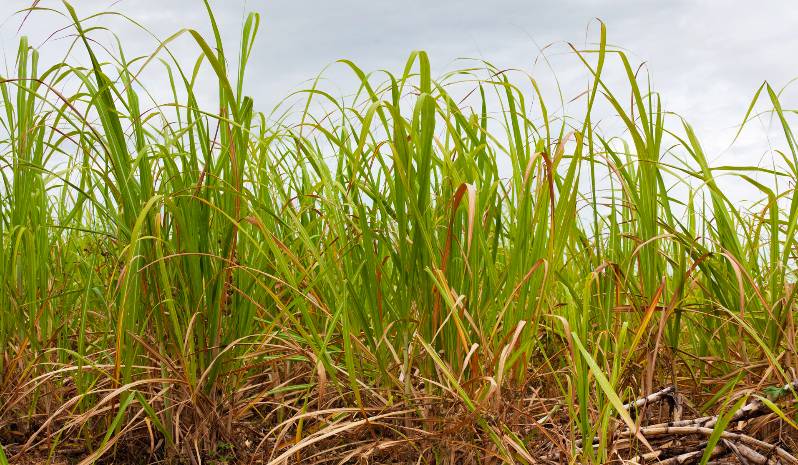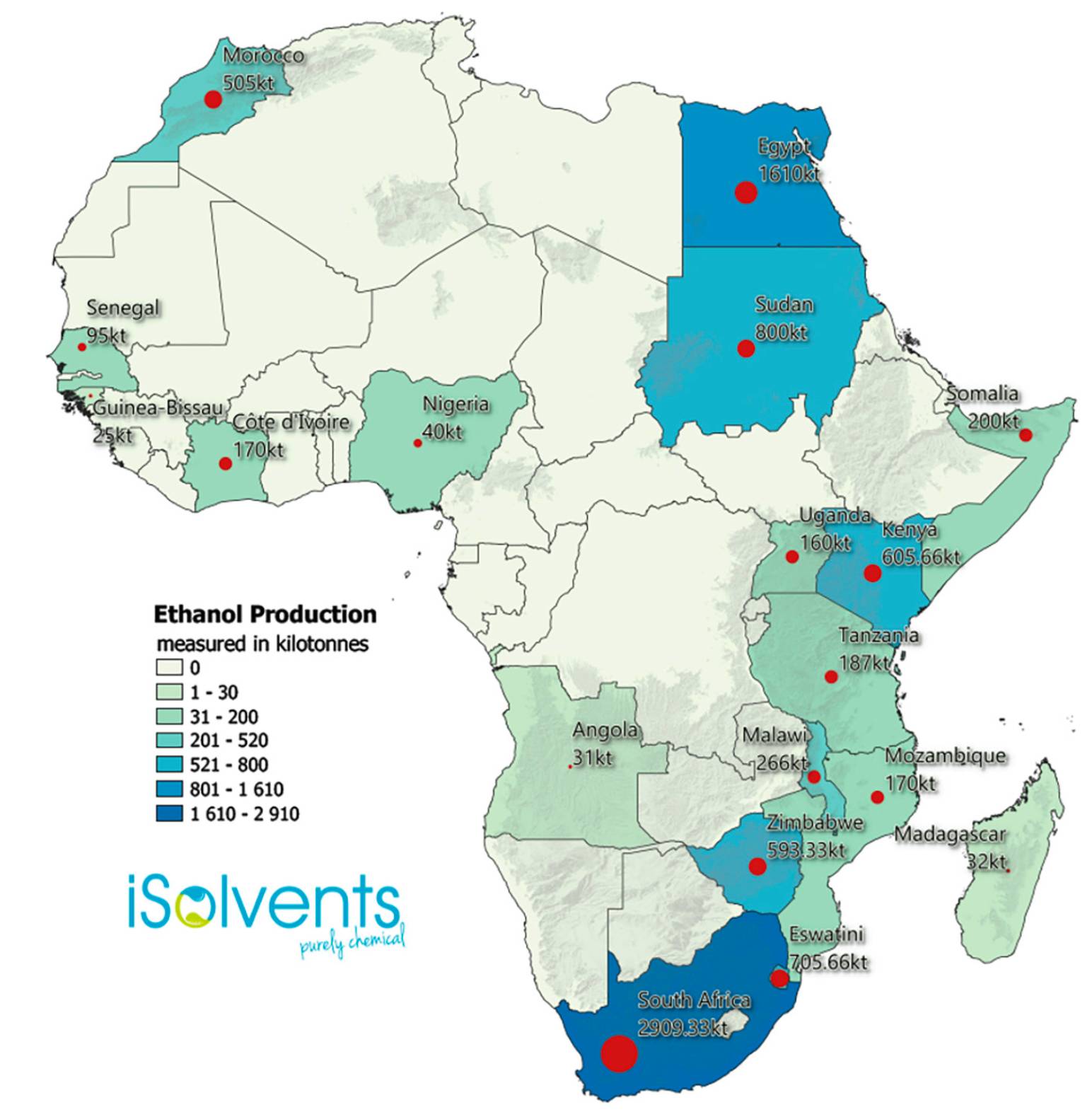Ethanol: a key resource for healthier living in Sub‑Saharan Africa
MARCH 20, 2022 | @Chris Nell
Most of Africa is home to third world countries with few pockets of western living standards. With Africa having little need for combustion of fuels for heating purposes, there is little consideration for proper use and improvement on fuel. This is true for local communities, and even national governing parties. Many African countries are inactive in their
 Figure 1: Ethanol production in Africa
Figure 1: Ethanol production in Africa
response to international urges of adopting better fuel usage – such as ethanol – as a fundamental and reliable source of energy. They retain the mindset that ethanol is only a luxury commodity and not a necessary compound for healthier living. However, some countries are shifting their view to recognize ethanol as a viable good in the energy industry. Although there is no guarantee of total economic reform for ethanol just yet, there is potential as government shows change, seeing more value of ethanol as the versatile fuel that it is. Despite the current lack of ethanol availability, there is promise that ethanol could be the answer to many fuel challenges in Sub-Saharan Africa, with South Africa being the lead producer as seen in Figure 1.
 Figure 1: Ethanol production in Africa
Figure 1: Ethanol production in Africa
Ethanol is the favourable alternative
Since the early 2000's, the fuel industry in Africa has pushed to focus on ethanol as a feasible and accessible fuel-alterna- tive. The greatest driving force behind this industrial repositioning would come from the established sugarcane trade in Sub-Saharan Africa. The commercial process involves the breakdown of glucose into ethanol by the process of fermenta- tion. The ethanol acquired from this simple fermentation process must be purified by further distillation, to produce a desired ethanol concentration of 95%. Some African countries have sugarcane plantations that have the capacity to manufacture ethanol in this way. And with the falling cost of sugarcane and the rising cost of other energy resources (such as lead additives in gasoline), economic conditions have become more and more favourable in the last couple decades.
Coal and wood are frequently used energy sources in Africa by means of burning. This is mostly seen in processes of food preparation, which can present issues when food is cooked over fires indoors. A study carried out in Nigeria, in January 2017, shows that frequent cooking over fires has detrimental health effects. There are cases of women diagnosed with dangerous levels of high blood-pressure – which proved to correlate with frequent exposure to harmful gases released from anthracite coals and wood. If ethanol is more accessible to countries such as Nigeria, individuals living in third world countries would face fewer health concerns. Beside this, the ecosphere and industrial sectors would benefit from ethanol as an alternative fuel for cooking and heating.
| Aspect of comparison | Ethanol as fuel | Coal or wood as fuel |
|---|---|---|
| Industrial value | Provides outlet for molasses that otherwise goes to waste | A non-renewable energy source |
| Agricultural value | Helps stabilize agricultural sector | Marginal impact on deforestation |
| Greenhouse effect | Cane-derived ethanol has low net-emission of greenhouse gases | Marginal impact on carbon dioxide emissions, but does release harmful gases |
Table 1: compiled from results under research at Princeton University, showing the advantages of ethanol as a combustion compound in industry
Overcoming the first limiting factor of transport
Despite the promising reward from using ethanol as a replacement of coal and wood, fuel ethanol programs do not spring up autonomously. These programs are tightly bound by local and international limitations, and both are addressed by upscaling agricultural transportation. Ethanol seems to be an attractive alternative for fuels in Africa, but to realize this potential requires designed programs which are adapted to local conditions. These programs are well under- way in Tanzania, Zambia, Malawi, Mozambique, Madagascar, and Zimbabwe – bringing positive change that is desired by many, especially by the Project Gaia organization.
The plan is to help their organization by establishing the programs with clean ethanol. They’ve helped us see the commercial value of these projects, yet they are limited by a lack of clean ethanol. commercial projects seem promising but are limited by a lack of clean ethanol. To date, most of the ethanol in Sub-Saharan Africa is not food-grade nor does it burn cleanly. So, there is a great buy-in into the market of ethanol with cookware such as ethanol stove tops, which would improve the quality of life in the general population of Sub-Saharan Africa – alleviating health issues from local communities and stimulating ethanol as a local commodity in the international economy.
Overcoming the bigger challenge
The chief problem in Africa is clean food-grade ethanol being rare to come by because of constraints on ethanol supply and high pricing. With resistance from governing authorities in changing their energy policies, the only way to go about increasing the use of ethanol is by creating a supply-and-demand through importation. The boost in ethanol trade would be picked up locally first by the help of projects undertaken by Project Gaia and their cooking programs on ethanol stove tops. Here importation would be important for the procurement of ethanol which can eventually lead to greater production of ethanol, ultimately leading to win over corporate bodies and government to consider ethanol as a viable fuel.
South-Africa, being the leading country in manufacturing clean food-grade ethanol of over 95% purity, could pave the way for the rest of Africa. Several shipping ports in South Africa (such as Port Elizabeth, Cape Town, and Durban) are already seeing bulk ethanol trade within the beverage industry. This will lend opportunities for established entry points to international harbours such as Lagos and Mombasa, having established fast-track shipping to and from South Africa. There is great promise that South Africa could lead Sub-Saharan African countries out of energy poverty through sustain- able ethanol trade.
Creating a supply and demand
Knowing that creating a supply and demand is the best economical solution currently, we can serve the ethanol supply in several ways, including the healthier option of cooking from an ethanol stove top. We at iSolvents procure and distrib- ute ethanol with a ranging concentration of 96.2% to 99.9%. Our ethanol is produced either by distillation or synthetical- ly by hydrogenation. This satisfies the requirement for food-grade ethanol. Moreover, with the range of ethanol blends we offer, many industries can benefit as shown in the second column in the table below.
| Our Ethanol Blends | Industrial Impact | Application | Schedule 6 code |
|---|---|---|---|
| Pure ethanol (96.4-100%) | Food and beverage industry | Used as a fuel in ethanol stove tops | |
| Blended with 3% Iso-propyl alcohol (IPA) | Paint and Medical industry | IPA dentures the ethanol, making it a suitable adhesive, sterilizer, and anti-freeze agent | F2 |
| Blended with 0.01% Butyl alcohol and Bitrex | Cosmetic industry | This denatured ethanol is suitable for topical use and doesn't irritate the skin | F3 |
| Blended with 0.2% Acetaldehyde | Pharmaceutical industry | The ethanol undergoes a chemical change making it suitable as an alternative for ascetic acid | F7 |
| Blended with 3.5% Butanol | Ink and printing industry | Adding Butanol makes the ethanol mixture a suitable compound to which dyes can be added | F8 |
| Blended with 2% Ethyl acetate | Science and Pharmacology | This denatures the ethanol making it suitable for use as an extraction agent in solution | F6 |
Table 2: some of the ethanol blends that iSolvents make and distribute internationally
Our desire is to serve Sub-Saharan Africa by giving all people better access to clean and well blended ethanol. This is in everyone’s interest as it impacts economically marginalized individuals, those who are employed in the industries mentioned, and overall health and wealth of Sub-Saharan Africa. This will be seen more as we move from non-renewable fuel sources to renewable fuel sources like ethanol. South Africa has committed to the PARIS agreement which aims to strengthen global response to use cleaner fuels, and here we have a great opportunity to make that a reality..